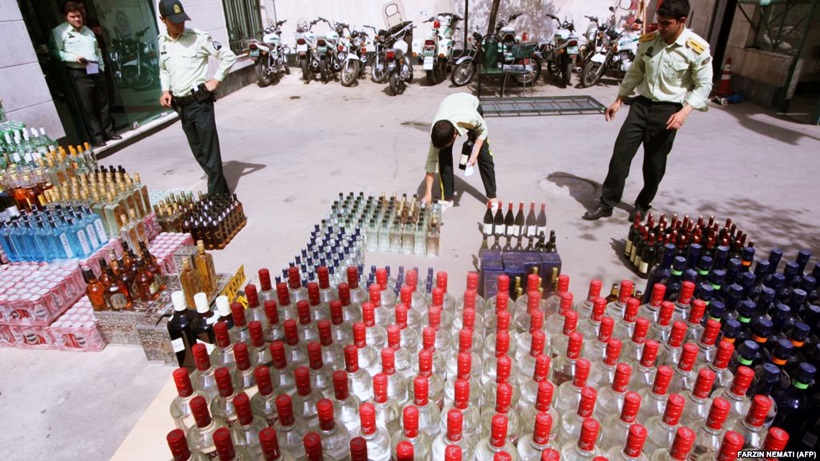Mon 15 July 2019:
Since last winter, over two dozen people have lost their lives after drinking counterfeit and bootleg alcoholic beverages — seven in Fars province, 10 in East Azerbaijan, four in Isfahan and five in West Azerbaijan. This is in addition to the hundreds who were hospitalized, sent to intensive care units, went blind or had to undergo kidney dialysis due to alcohol poisoning.
The biggest wave of alcohol-related death and poisoning occurred in the late summer and early autumn of 2018 when, within less than two months, 947 people were poisoned; 85 of them died.
Deaths and poisoning linked to illegally-produced alcoholic beverages have repeatedly made the headlines in Iran, but the recent wave has commanded more attention than usual due to the apparent spread of the problem, with at least 13 Iranian provinces, from Hormozgan and Fars to Tehran, East Azerbaijan, West Azerbaijan and Kohgiluyeh reporting incidents. Police have even found bootleg workshops in small cities like Estahban and Jahrom.
The Nuclear Agreement and Counterfeit Whiskey
The production and consumption of alcoholic beverages were both prohibited after the 1979 Islamic Revolution. According to Iran’s Islamic Penal Code, the punishment for drinking alcoholic beverages is 80 lashesfor the first and second offenses, but the third offense can carry a sentence of death. The punishment for making and selling alcoholic beverages ranges between 74 lashes to one year in prison. As a result, smuggling alcoholic beverages into the country has been a lucrative business over the last four decades.
Even though during these years most of the victims of poisoning have been people drinking domestic bootleg alcohol — usually a spirit distilled from raisins that contains 65 percent ethanol — in the last year the number of people poisoned after drinking alcohol sold under counterfeit foreign brand names has increased sharply.
Last year, Ahmad Rahmanian, Deputy for Crime Prevention at the Justice Bureau in Fars Province, said that these beverages are made from poisonous ingredients but are sold in bottles with convincing brand-name packaging.
The basic ingredient of many of these fake and poisonous beverages is methanol, often called “wood alcohol” because it was once produced by distilling wood. Methanol has many industrial uses, but drinking more than 150cc of it can cause death, and even in small amounts it can cause blindness and other incurable physical damage.
According to reports by the Iranian media, producers of these alcoholic beverages will sometimes not just add chemicals to improve the taste and color of the alcohol, but also opioids including diazepam, tramadol and methadone that, when combined with alcohol, will likely cause death.
But why this sudden wave of poisoning from drinking counterfeit alcoholic beverages? A number of Iranian reporters and people on social networks believe it has been caused by the steep rise in the cost of the US dollar, and, in turn, the resulting hike in the price of smuggled alcoholic beverages.
Hoda Hashemi, a reporter for the social affairs page of the newspaper Iran, tweeted in March that the price of some “imported” (smuggled in) alcoholic beverages that used to cost between 200,000 and 250,0000 tomans ($16-20) have recently quadrupled. So recently some smugglers have begun to buy and import bottles of brand-name beverages for up to 50,000 tomans ($4) and then fill them with bootleg alcohol, which is often poisonous and dangerous.
One person posted on Twitter that before the leap in the price of the dollar, a bottle of Absolut vodka cost somewhere between 120,000 and 150,000 tomans ($10-12), but the price has now gone up so much that not many people can afford it.
From Warnings to Insults
Whatever the reasons are for the rise in the production and consumption of counterfeit alcoholic beverages, the trend has led to widespread warnings from experts, social and political activists and some government officials. Last year, Iraj Hariri, a spokesman for the Ministry of Health, reported that in the short time between September 7 and September 30, 2018, 460 people in five provinces were brought to medical centers after being poisoned by alcoholic drinks. According to him, out of this figure, 42 people died or suffered severe brain damage that left them unable to live without a life support system, 16 went blind and 160 had to receive dialysis treatment.
“People must go to a medical center if they experience symptoms such as vomiting or nausea after consuming alcohol,” Hariri said. “Medical staff will treat them, and they are not under any obligation to report [what they have done] to anybody. By doing this they will both help themselves and give us notice that there is methanol in the area so we can warn other people.”
Just because it is illegal to sell and consume alcohol in Iran, this does not mean people have remained quiet when it comes to voicing their alarm over the rising numbers of casualties. “How many of our fellow countrymen must go blind or become brain dead for our statesmen to concede that their strategy in dealing with alcoholic beverages is wrong and has failed?” tweeted the reformist political activist Mostafa Tajzadeh earlier this spring. “Isn’t protecting the lives and the property of citizens the first duty of any government?”
The lawyer Musa Barzin Khalifehloo told IranWire that, according to the law, the regime has no responsibility toward the victims of these poisonous substances because it has prohibited alcohol consumption. “Nevertheless,” he said, “when a government prohibits the consumption of something, it has to deal with its illegal production [when it] causes harm. In fact, the government must be held responsible for not dealing with this production.”
While a number of media outlets have published statistics about the victims of unsafe alcoholic drinks and have called for immediate solutions, the newspaper Kayhan — the managing editor of which is appointed by the Supreme Leader — has expressed its own ideas about the matter. “They will go to hell,” an article published in Kayhan said. “They deserve it. If they had not drunk liquor they would have not dropped dead. Why do these dirty germs deserve to be alive at all?”
Historical Roots
Apart from Iran, the consumption of alcohol is also prohibited in 10 other Islamic countries, including Saudi Arabia, Kuwait, Yemen and Libya. The difference, however, is that in those countries drinking alcoholic beverages lacks deep historical roots. So among the peoples of these countries, religious beliefs have been stronger than the interest in alcohol. But Iran is different because it has a long history of producing wine. Historical evidence shows that wine was made in northeastern Iran as far back as 5,500 years ago.
Wine found a special place in the religious ceremonies of the Zoroastrians, and they drank wine even during funeral ceremonies. Glasses and other containers holding wine can be seen in pre-Islamic friezes and ornaments. After the Arab conquest of Iran, the ban on consuming alcohol was sometimes enforced and sometimes ignored, but even after the Islamic Revolution many Iranians did not stop drinking alcohol and many continued to offer alcoholic drinks when entertaining guests. However, the legal ban on the sale of alcohol made drinking it a risky affair.
In one shocking case from June 2013, more than 350 guests at a wedding and a birthday party in the southern city of Rafsanjan were poisonedafter drinking methanol. Seven of them died and 10 others went blind.
In the early 2000s, a number of factories were permitted to produce ethyl alcohol and to sell these products to pharmacies. It is reported that 23 factories were given permission to engage in this activity. But a short while after they received these permits, they were forced to add a chemical to make their products taste bitter, making the alcohol more unappetizing to drink.
Prohibition raises alcohol consumption
Prohibiting a commodity that people do not believe should be prohibited can end up increasing its consumption. “Alcohol consumption in Iran is higher than what the statistics show,” the sociologist Eli Khorsandfar told IranWire. “In a sense, since drinking alcohol is one of the redlines of the Iranian government, people sort of show their defiance toward the government by consuming alcohol. When the people do not like what the government has imposed on them against their will, then they consume it more.”
“When the government sets a redline on something, then statistics and information about crossing this redline cannot be accurate and reliable,” Khorsandfar says. “For instance, when they report that last night a police caught a ‘corrupt gang’, most likely they mean a mixed-gender party [another red line for the regime, though not necessarily a party where alcohol was consumed]. Therefore, it makes sense that the number of those poisoned by counterfeit alcoholic beverages is higher than what is officially reported.”
According to Khorsandfar, the increase in people’s interest in consuming alcohol in Iran has its roots in the absence of security, prosperity and entertainment when compared to secular countries. He believes that Iranian people have no other entertainment apart from dining in restaurants or having family parties behind closed doors. “But,” he adds, “this is a temporary sedative. When things are done in secret, the chances for foul play increase and underground corruption spreads. The government does not have reliable data, nor can it do anything to prevent it.” He believes that many Iranians who travel to other countries do so to freely drink alcohol, and, in the case of women, also remove their hijab, which is mandatory in Iran.
“In the mid-1990s, I boarded an [Iranian] bus to Turkey on an assignment,” one reporter said. “At one of the checkpoints inside Turkey an officer boarded the bus for a quick inspection and was shocked by the overpowering smell of alcohol. He told the passengers he did not understand why when you board an Iranian bus the smell of alcohol is so intense. ‘It is so intense that you fear that if you strike a match the bus would explode!’ he said.” Although this is only one anecdotal account, it is a nod to the extensive counter culture in Iran today — and a reminder that many people will go to great lengths that people will go to ensure they these forbidden parts of their lives continue.
Iran Wire





